After a 37-hour labor with my first baby, I was eager to do whatever I could to shorten my labor with my second baby. Figuring out how to progress labor more efficiently can really help speed things up. It can also reduce your risk of having unwanted interventions.
Whether this is going to be your first labor, or you have done this before, learning how to progress labor is something every expecting mama needs to do as part of her labor preparation.
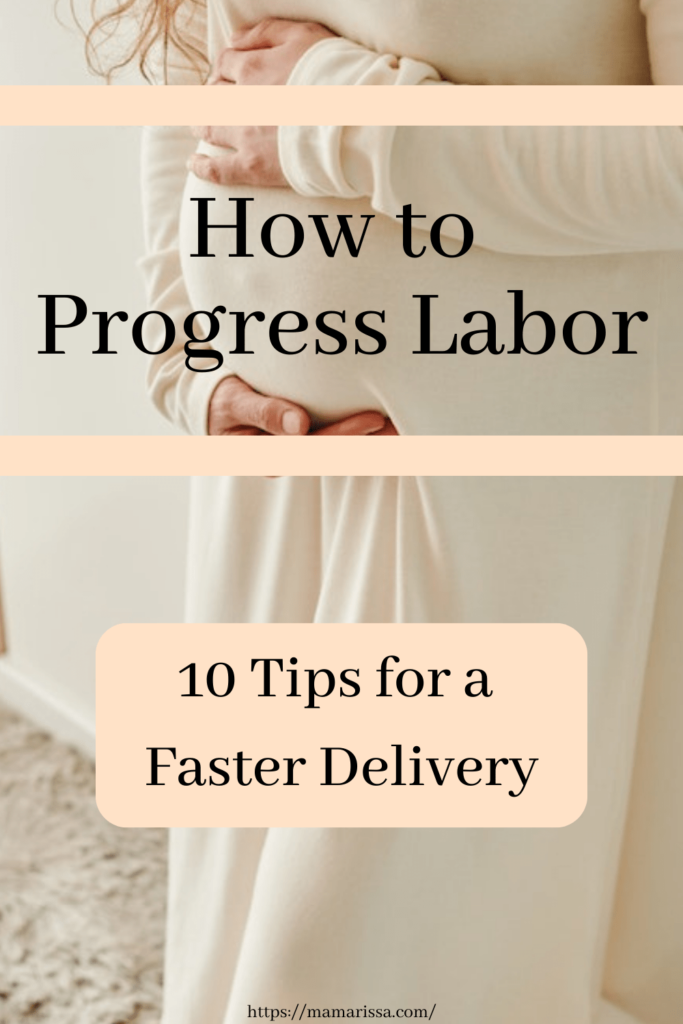
Why is this topic so important?
Because having a long labor is utterly exhausting and you might be pressured by your doctor or midwife to deliver faster if you want to avoid interventions. Similarly, having a stalled labor is frustrating and can lead to problems that necessitate more invasive care.
In this post, I will be sharing with you some of the most effective methods for how to progress labor Additionally, I will tell you which method I believe was the most effective for making my second labor less than one-third of the length of my first labor. I will also reveal which method successfully pushed me through an almost-stall point in my second labor.
So, Mama, if you are wondering how to progress labor, you are in the right place. I was in your shoes just a few months ago searching for the most effective ways to move labor along. And now I am on the other side to tell you what worked!
Please note that I am not a medical professional and nothing in this post is meant to be or replace medical advice. Please consult your OBGYN to determine if these tips are safe for you and your baby.
How to Progress Labor
1. Eat Dates
You may have heard about this first tip if you have already done some research on how to progress labor. I hope you have a sweet tooth, Mama, because you will need to eat dates daily in the weeks leading up to labor to make it progress faster.
Eating 6 dates every day for the last few weeks of pregnancy has been shown to reduce the length of labor, reduce the need for artificial hormones to augment labor, increase the likelihood of going into labor spontaneously, and improve cervical ripening. You can take a look at this study and this study to read more on those results.

I did not do this before my first labor, but I did before my second. And my second labor was indeed much shorter in every stage. Considering the evidence from the studies, I would say this probably did contribute to progressing my labor more quickly.
It certainly can’t hurt to try it! Of course, this will be harder to do if you don’t particularly like the taste of dates. But if you blend up dates with some water, you can make date paste. I have used date paste as a sweetener in baked goods, in oatmeal, on pancakes … There are many ways to use date paste.
But if you don’t have a few weeks until your due date, don’t worry. The rest of my tips for how to progress labor can be used while you are in labor.
2. Ignore it
This might sound odd, but one of the best ways to handle early labor is to ignore it for as long as you are able to. There are a couple of reasons for this.
First of all, it may be a false alarm. False starts to labor (known as prodromal labor) are very common, particularly in second-time (or third or fourth …) moms. It is incredibly draining mentally and emotionally to keep thinking and hoping that you are in labor. And, as a result, you will also end up physically drained.
Do you have your Baby’s First Year Journal yet, Mama? Get a FREE one here!
If it is real labor, it could still be quite a while before you are in active labor. You don’t want to use up your energy obsessing over timing infrequent contractions and monitoring every little twinge in your body to determine if anything more is happening yet.
I know it is really hard to do when you are eagerly waiting for labor to start. But you have to do your best to ignore the contractions or cramps or whatever symptoms you are having until they are intense enough to demand your attention. Conserve your mental energy for when you will really need it.

Of course, this piece of advice should only be taken if it is safe for you and your baby. Some women may have complications or circumstances which make it necessary for you to closely monitor when you may be going into labor, so make sure you talk to your doctor or midwife about when they want you to call them. Also ask what labor signs to watch for that indicate you should head to the hospital.
3. Bounce on an Exercise Ball
Maybe you have been trying to ignore the cramps for a while now and they are not going away. But you still don’t know if this is really labor. Or maybe you’ve had a little bit of discharge but can’t quite determine whether or not your water broke.
Bouncing on an exercise ball is a great way to help put a little extra pressure on your cervix to help it ripen and open for labor. You can also do hip circles on the ball to help get baby in optimal birthing position.
I bounced on my exercise ball a lot those last few weeks of my pregnancy with my second daughter. I had a lot of false labor and I kept hoping to move things along if it was the start of early labor.
And then, the last few days before I went into labor, I started frequently having just a little bit of discharge and was trying to determine over and over if it was my mucus plug or my water breaking. It did not seem to match the description of losing my mucus plug (I never noticed losing my mucus plug with my first labor). But I never leaked enough that I could be certain as to whether or not it was my water breaking.
Finally, during the early morning hours of the day that I went into labor, I had more substantial discharge, although still not enough to be sure it was my water breaking. So I bounced on the exercise ball to help things along if it was my water breaking. And sure enough, after a few minutes of bouncing, my water broke quite obviously (as in, I needed to shower and change clothes).
Read My 2nd Natural Hospital Birth Story to get more details on what happened in labor.
So for me, bouncing on the exercise ball definitely helped progress my labor.
Waiting for labor can be hard, but aren’t you glad that at least some of these tips for how to progress labor are surprisingly easy?
By the way, this is an affordable exercise ball if you don’t have your own yet. If you are early in your pregnancy, you will be using this throughout your entire pregnancy for exercise, stretching and just sitting.
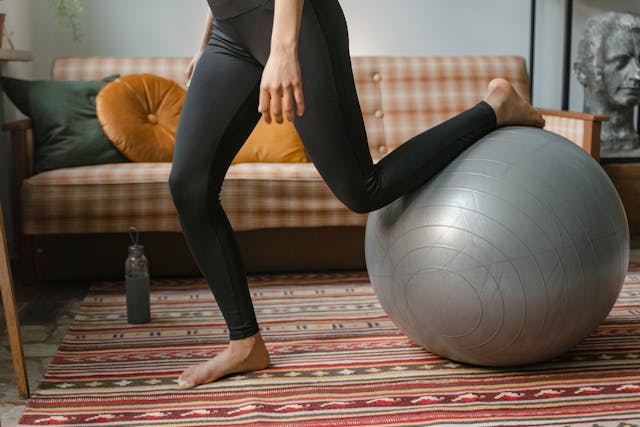
If you are close to the end and do not yet have an exercise ball, you still need to get one. An exercise ball is a great tool for helping you stretch and loosen your hips in those last few weeks of pregnancy as well as during labor. You can even bring it with you to your birthing place if they allow it.
And if you are thinking an exercise ball will be a waste of money because your due date has come and gone already and you don’t have much time left to use it, let me assure you that you will be using it after birth too. I have been using my ball just as much since my baby was born as I was while I was pregnant. With both of my babies, it has been the most effective way to bounce and soothe them during fussy times.
4. Walk
I was given some tips by other moms during my recent pregnancy about how to progress labor. More than anything else, I was told repeatedly to walk. Walking is a great way to get ready for labor and get labor started. But it’s also a really good way to keep it going, particularly in the early stages.
Walking in early labor is the number one thing that I believe moved my second labor along much quicker than my first. After my water broke with my second labor, I ate something, and then I just focused on walking for the next couple of hours.
I was determined to walk for as long as I could and get my baby out as quickly as possible. And I did just that. While my first labor took 37 hours, my second only took 11 hours.
With my first birth, I had heard conflicting things about walking versus resting in early labor. I was worried about using up too much energy early on and being worn out before labor was over.

Unfortunately, I ended up causing this exact problem for myself by not walking enough to help progress my labor faster. My first labor went so long that it was extra exhausting. I wasn’t sure if I would even be able to finish pushing my baby out by the time we were at the end.
I have known since shortly after giving birth the first time that I wanted to walk a lot more during labor with my second baby. And it definitely paid off.
5, Do Squats & Lunges
Squats and lunges are good for progressing labor because they help open your pelvis to make room for the baby. These exercises make it easier for baby to settle into position and put pressure on your cervix to help it open.
I did a lot of squats, lunges and general stretching during pregnancy to prepare for labor. I also did them while I was in labor. As I walked around our house, I went up and down the stairs and I paused now and then to do some lunges on the steps.
However. as with everything mentioned here, please consult your doctor before adopting this exercise. Also take a look at this article from Lamaz.org for some reasons why it may not always be a good idea to do squats while in labor.
I can’t really tell you to what extent the squats and lunges helped to progress my labor, but I read that it should be done and I did it. I know that doing lunges and squats definitely helped me to feel more relaxed and loose during pregnancy, though.
Check out this post for tips on how to handle the discomforts of pregnancy.

I also know that midwife Ina May Gaskin talks in her book Ina May’s Guide to Childbirth about how important it is to be in an optimal position for giving birth in order to widen the opening. I gave birth to my first daughter standing and squatting. I thought it made perfect sense to allow gravity to help me out and do what I could to widen the area from which the baby would be emerging.
I tried to also give birth to my second daughter squatting on my knees on the hospital bed. But the nurse could not read her heart rate in that position. So I had to lay on my side at the end.
My midwife apologized afterward that I had not gotten to birth in the position that I wanted to. But she had been worried about the safety of my baby and I was just glad I got her out in time. It didn’t really matter to me at that point what position I had given birth in.
6. Stay Home as Long as You Can
This one might not sound like advice for how to progress labor. But it is. Staying where you are most comfortable is essential for continuing to move labor along. It is pretty much a given for most laboring women that labor will slow down or even stop when you go to the hospital.
This is partly because you are no longer as relaxed as you were at home. The car ride is uncomfortable and the process of checking into the hospital is disruptive. Not to mention the fact that just being in a hospital can be disturbing to the subconscious if not the conscious mind.
All of these things effect your mental state and your mental state effects what your body is doing.
Get access to my best advice for conquering labor fear for FREE here!

But don’t worry. Labor will most likely pick back up after you have settled into your hospital room. Just the same, it can be hard to get back into the same groove of laboring as you had at home. You’ve got nurses asking you questions, cervical checks, possibly an IV being started and all manner of interruptions that are not conducive to a peaceful mental state that keeps labor moving smoothly.
For this reason, it is a good idea (with your doctor or midwife’s approval of course) to try to labor “comfortably” at home for as long as you can. And that length of time will be different for different women.
I’ve often heard OBGYN’s tell pregnant women to come to the hospital when they feel they are no longer coping well with the pain – even if they don’t want an epidural. The nurses have suggestions and things they can offer to help you through the contractions if you feel like you need that help at any point.
With both of my labors, I got to a certain point at home when I felt like I wasn’t really thinking clearly anymore and that is when I went to the hospital. With my first labor, I was 5 centimeters dilated when I arrived. With my second, I was 7 centimeters dilated.
I have heard plenty of stories of women who are in so much pain and they go to the hospital to find that they are “only” 3 centimeters dilated. That is okay! It’s really not about how dilated you are, it’s more about how you are feeling.
But if you feel like you are progressing at home and you don’t think you are getting ready to push soon or need to be at the hospital for any other reason, just stay home and keep in touch with your doctor or midwife.
7. Stay Up and Keep Moving
This is kind of the same idea as walking but a little bit modified for when you don’t feel you can walk. If you cannot walk due to pain or other physical restrictions around you (like being hooked up to an IV or having to stay in a small room), the next best thing is to stay up and keep moving in place.
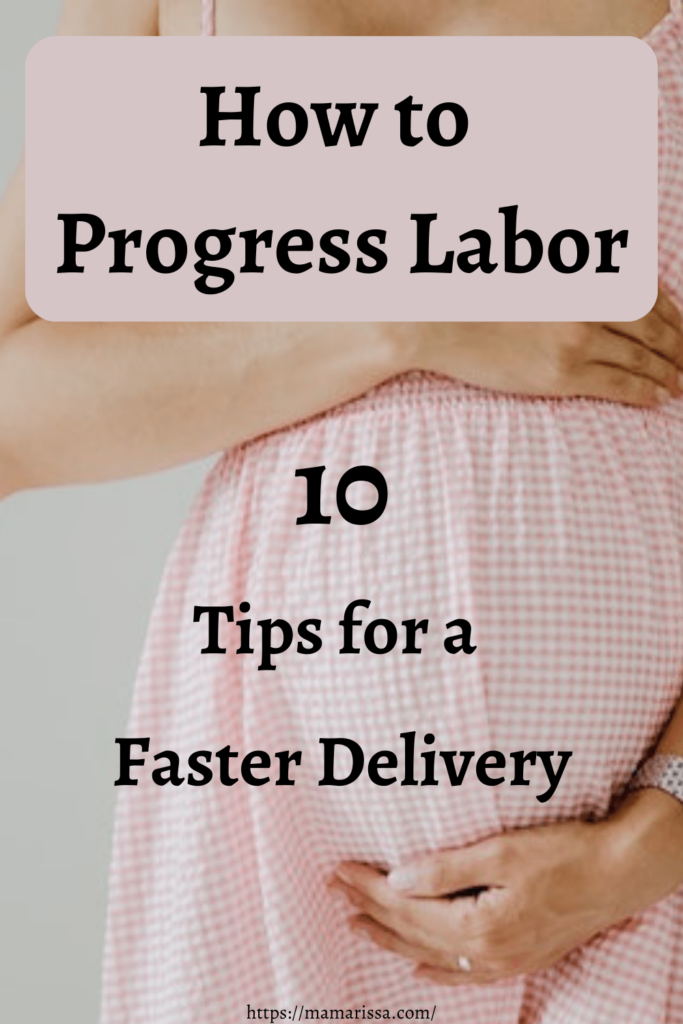
Once I got to the hospital with my first labor, aside from taking a couple of slow walks up and down the hall at first, I mostly laid in bed for the rest of my labor until the end of the pushing stage. I was so tired and exhausted, but I really feel I should have tried to get up a little more to keep things moving.
With my second labor, I was afraid to be off my feet at all because I just wanted to get the baby out as soon as possible. I was also so uncomfortable during contractions that I simply had to move. So I stood, leaned over the bed and swayed through every contraction while my husband applied counter-pressure to my back.
You know how things that are in motion tend to stay in motion? Yeah, that is the idea of continuing to move throughout labor. You want that baby to keep moving down, which means you need to keep moving too. Being upright will also allow gravity to help pull the baby down easier.
8. Relax
It is so important to relax your body during labor. And when I say relax, I’m not talking about the kind of relaxing you would do if you were laying on the beach getting a massage. That kind of relaxing takes zero effort.
On the contrary, relaxing when you are in labor takes effort. It is not easy. It does not come natural to relax while you are in labor. When you are in pain or uncomfortable, your body naturally wants to tense up.
So it is up to you to make the conscious effort to relax your cervix. If you actively picture your cervix relaxing, it will do it. Take note of any body part that is tense and actively relax it. It is not easy, but it is essential for progressing labor.
You may not feel like you even know how to relax down there. Yeah, I totally relate.
I used to listen to women on YouTube sharing their birth stories and talking about staying relaxed and open. I did not really know that they meant by that.
But the best advice I followed in this regard was to simply imagine something relaxing or opening. For example, imagine a tiny circle getting larger and larger. Or imagine a stiff piece of uncooked spaghetti gradually going completely limp as it cooks.

You might not understand the body part you are actively trying to relax. But visualizing something relaxing and opening can help make it happen just the same.
9. Rest
Okay, I know I said to stay up and moving. But unless your labor is exceptionally short, there will probably come a point (or several) when you need to take a break and rest. I might have pushed myself just a little bit too long with the “staying up and moving” part because I was afraid of labor stalling if I laid down.
Ironically, I think staying up a little too long actually ended up stalling my labor a bit. I had arrived at the hospital four and a half hours into my labor at 7 centimeters dilated. When the nurse did another cervical check four hours into my time at the hospital, I had only progressed an additional 1 1/2 centimeters.
At this point, I just stayed in bed and rested the best I could between contractions. And I very much believe resting allowed my body to pick up the progress again. Since arriving at the hospital, I had been trying so hard to keep things moving by not laying down. But once I did lay down, I progressed much quicker.
After I had been in the bed for about an hour and a half, I was fully dilated at 10 centimeters.
So how are you supposed to know even to stay up and moving and when to rest? You just have to trust your body and do whatever it is telling you it needs to do in a given moment. It is important to keep moving when you are able. It is also important to rest when you feel you need to.

I don’t think that I did anything wrong throughout my labor and I’m not sure there’s anything I could have done better. I am really glad I stayed up and active for as long as I could. But I’m also really glad I decided to stay in the bed and rest for that last hour and a half.
10. Change Positions
Changing positions is really important during labor. Some positions might work really well to help you progress but they are extremely uncomfortable. Other positions might ease your pain but hinder your progress. And still other positions might help you progress and keep you more comfortable.
Sometimes your baby doesn’t like a certain position. Sometimes your body just needs a change in position.
When I was in the pushing stage with my first labor, I changed positions multiple times because pushing lasted around 4 hours.
Read my first natural hospital birth story here.
I began lying on my side and had frequent contractions but I wasn’t making good progress with the pushes. So I got up onto my hands and knees to really move into the pushes. I made better progress with each push in this position, but my contractions slowed way down.
So the doctor and nurses suggested I stand and squat into the pushes. This was pretty effective but my baby kept receding after each push ended. So then a nurse brought me a stool to prop up one foot to help widen the opening a little extra as I squatted.
Finally, I got my baby out in this last position.
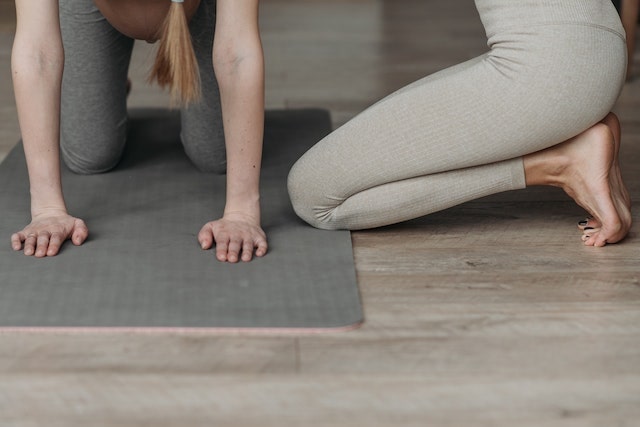
With my second labor, changing positions helped progress my labor by initiating the pushing.
After I had successfully gotten to 10 centimeters by resting in the bed, I was not feeling any urge to push. I knew that I needed to change positions and get up to let my body know that I was ready for the next stage (whether I felt entirely ready or not).
So I got out of bed and stood beside it. Soon after, I began to feel the urge to push.
Changing positions is absolutely essential during labor. Not only can it effect your comfort level, but it can dramatically change the course of how your labor progresses.
Short vs. Long Labor
Most mamas want to avoid a lengthy labor. And it makes sense. Who would choose to spend 37 hours in labor?
The downside to having a quicker labor is that it might be more painful. I was told so many times that shorter labors are usually more painful. But when I was preparing for my second labor, I still knew that I wanted a shorter labor than my first.
My second labor was much shorter than my first because of all the tips mentioned in this post. And I will admit that it was indeed more painful. However, I was still very satisfied that it was significantly shorter. My recovery was so much easier with my second labor and the exhaustion of labor did not take as long to overcome afterward.
And even though my first labor was not nearly as painful as I expected it to be, it certainly was not comfortable. If I were given the opportunity, I would choose the shorter labor again.
Have you used any of these tips for how to progress labor? Do you have some additional tips? If so, tell me about it in the comments!
And please share this post on social media so that all your expectant mama friends can have a quicker, more efficient labor!
Hey Mama, if you find my blog posts helpful, would you help support this blog by making Amazon purchases through the links on this page? It will not cost you any extra but the commissions I receive as an Amazon Affiliate help to cover the costs of operating this blog so that I can keep it running ad-free. Thank you so much for your support. You are literally the reason this blog was started and the fuel that motivates me to keep it going!

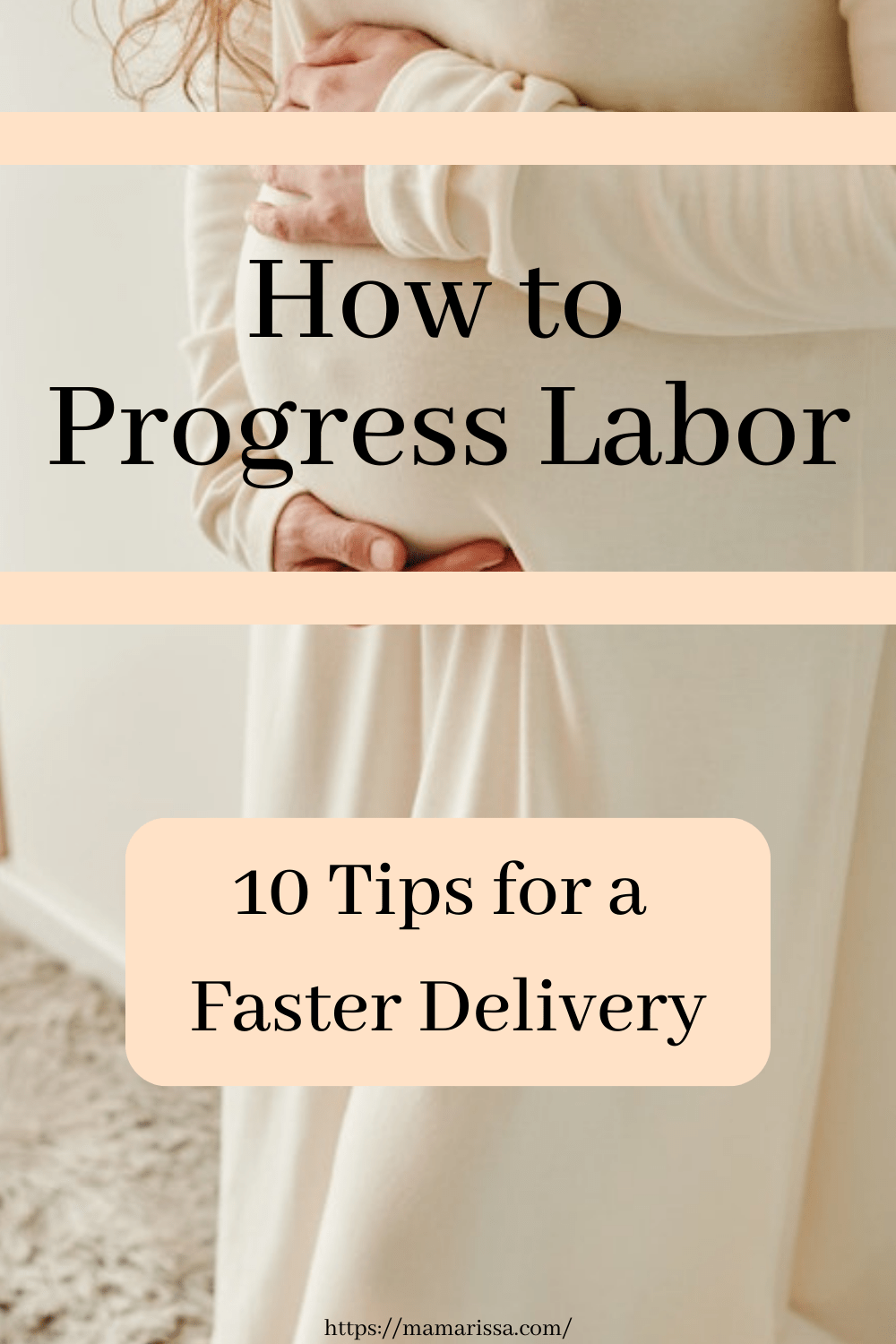










Leave a Reply